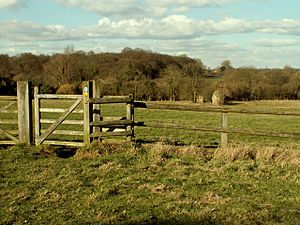Tilty Abbey facts for kids
Tilty Abbey was a Cistercian monastery located in Tilty, Essex, England. Monasteries were places where monks lived and dedicated their lives to religious practices. Tilty Abbey was closed down on March 3, 1536, during a time known as the Dissolution of the Monasteries. Today, part of the old abbey, especially its chapel built around 1220, still stands and is used as a local church.
Contents
What Was Tilty Abbey?
Tilty Abbey was a home for Cistercian monks. The Cistercians were a group of Catholic monks who followed strict rules. They lived simple lives, focusing on prayer, work, and quiet reflection. Abbeys like Tilty were important centers in their local communities. They often owned land and helped people living nearby.
Life at the Abbey
Life for the monks at Tilty Abbey would have been very structured. Their days revolved around prayer, study, and manual labor. They grew their own food, made their own clothes, and copied books by hand. The abbey would have had many buildings, including a church, dormitories for sleeping, a refectory for eating, and cloisters for walking and meditating.
The Abbey's History
Tilty Abbey was founded a long time ago, likely in the 12th century. Over the years, it grew and became an established part of the Essex landscape. Like many monasteries, it played a role in the local economy and spiritual life. The chapel, which is still standing, was built around the year 1220. This shows how old and historically important the site is.
What Happened to Tilty Abbey?
In the 1530s, a major event called the Dissolution of the Monasteries happened in England. This was when King Henry VIII decided to close down all monasteries. He did this for several reasons, including gaining wealth and power. Tilty Abbey was officially dissolved on March 3, 1536.
The Dissolution Process
When Tilty Abbey was dissolved, an official order was made. The abbot, John Palmer, and his five fellow monks were allowed to stay at the abbey for a short time. They had to manage the property under new rules. The abbot was also allowed to keep his five servants and continue to support three people who depended on him: his mother, Alice Mills, Agnes Lucas, and Thomas Ewen.
What Was Found at the Abbey?
When the abbey was closed, a detailed list was made of everything inside. This list, called an inventory, tells us a lot about what life was like there.
- In the Church: There were many beautiful items for religious services. These included fancy altar cloths, special robes for the priests (called vestments), and even an organ. There were also many candlesticks.
- In the Living Areas: The inventory listed furniture like tables, chairs, and benches. There were also practical items like cooking pots, kettles, and pewter plates in the kitchen. The abbot's rooms had nicer things, like carpets and a fireplace set.
- Valuable Items: Some precious items were found, including silver crosses, censers (used for burning incense), and silver spoons. Most of these valuable items were given to Mr. Richard Cromwell, a powerful figure at the time.
- Food Stores: The larder, where food was kept, had a supply of salted fish, including "salt fishes," "lings," and "stock fishes." This shows what kind of food the monks ate.
What Remains Today?
Even though the abbey was dissolved centuries ago, parts of Tilty Abbey still exist. The most important survival is the old chapel. This building, which was once part of the larger monastery, became the local parish church. It has been changed and added to over the years, but its ancient walls still stand, connecting us to the abbey's past.


